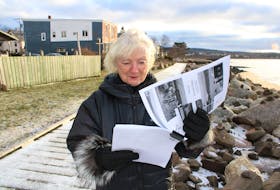They were hungry, and they knew they were being fed.
Helene Van Doninck, veterinarian and co-founder of the Cobequid Wildlife Rehabilitation Centre, knew it was their feeding time, but also wanted to check in on their nest.
"We started using the nests about 10 days ago," said Van Doninck, about hand knit and crochet nests that have been dropped off and delivered to the centre. "This is our first time using them, with the European starlings. They're usually the first birds we get anyway, because they're early laying."
The centre was contacted a few months ago about the knitted and crocheted nests of all shapes and colours. Van Doninck had heard about the idea, which was started in Ontario, but was a little skeptical about using them.
"I was worried their little toes might get caught in the yarn," she said. "But we were already making our own nests with tea towels, but those don't really hold together well."
She said many of the 50 to 60 "nests" the centre has received have come from New Brunswick and Prince Edward Island, but there have been some made locally as well.
"Sometimes we find random bags of them on our doorstep," she said.
The nest holds the shape of a real bird nest, which is familiar to the birds the centre will receive.
"If they can't pull their legs in, they might get issues with their thighs," she said. "Plus, it keeps them warm. We've been lining them with paper towel or Klennex to help with the clean up, but they wash really well. That was another thing I was skeptical about."
The veterinarian hopes there doesn't come a day when all of the yarn nests are being used at the same time, but she could have up to 30 in use during the busy season.
"Soon we could have about 30 baby birds, but we only have one pair now. We have a couple of rabbits and we thought about using the nests for them, but they're hopping around too much. For baby birds, they're certainly great."
Depending on the type of bird, the centre could see more than two in the nest.
"If we get groups of the same species, we can pile them together - it helps keep them warm, but if we have 20 different species, they have to be with their own species or something close to them," she explained, adding even social skills in birds need to be monitored.
With stashes of nests throughout her home, Van Doninck is thankful for those who have spent the time to create them.
"It works, it's conventional and it's a benefit to the birds. It's a good idea," she said.
Twitter: @TDNRaissa
They were hungry, and they knew they were being fed.
Helene Van Doninck, veterinarian and co-founder of the Cobequid Wildlife Rehabilitation Centre, knew it was their feeding time, but also wanted to check in on their nest.
"We started using the nests about 10 days ago," said Van Doninck, about hand knit and crochet nests that have been dropped off and delivered to the centre. "This is our first time using them, with the European starlings. They're usually the first birds we get anyway, because they're early laying."
The centre was contacted a few months ago about the knitted and crocheted nests of all shapes and colours. Van Doninck had heard about the idea, which was started in Ontario, but was a little skeptical about using them.
"I was worried their little toes might get caught in the yarn," she said. "But we were already making our own nests with tea towels, but those don't really hold together well."
She said many of the 50 to 60 "nests" the centre has received have come from New Brunswick and Prince Edward Island, but there have been some made locally as well.
"Sometimes we find random bags of them on our doorstep," she said.
The nest holds the shape of a real bird nest, which is familiar to the birds the centre will receive.
"If they can't pull their legs in, they might get issues with their thighs," she said. "Plus, it keeps them warm. We've been lining them with paper towel or Klennex to help with the clean up, but they wash really well. That was another thing I was skeptical about."
The veterinarian hopes there doesn't come a day when all of the yarn nests are being used at the same time, but she could have up to 30 in use during the busy season.
"Soon we could have about 30 baby birds, but we only have one pair now. We have a couple of rabbits and we thought about using the nests for them, but they're hopping around too much. For baby birds, they're certainly great."
Depending on the type of bird, the centre could see more than two in the nest.
"If we get groups of the same species, we can pile them together - it helps keep them warm, but if we have 20 different species, they have to be with their own species or something close to them," she explained, adding even social skills in birds need to be monitored.
With stashes of nests throughout her home, Van Doninck is thankful for those who have spent the time to create them.
"It works, it's conventional and it's a benefit to the birds. It's a good idea," she said.
Twitter: @TDNRaissa








